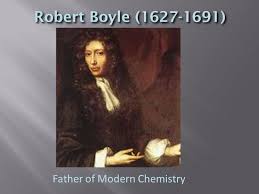Answers of Quiz 1893 (Robert Boyle and Chemistry)
1. 25 January 1627
2. Anglo-Irish natural philosopher, chemist, physicist & inventor
3. Boyle's Law describes the inversely proportional relationship between the absolute pressure & volume of a gas, if the temperature is kept constant within a closed system.
4. 31 December 1691
5. 64 years
6. Chemistry is the branch of science that deals with the properties, composition & structure of matter. Chemistry also deals with the changes involved in the matter. It also deals with the principles governing the changes which matter may undergo.
7. Jabir bin Hayan
8. Robert Boyle
9. Matter is anything that has mass & occupy space. As: Stone, Water, Air
Matter has 4 states: Solid, Liquid, Gas & Plasma
Solid: Solid has definite shape as well as definite volume. As: Stone, Chair, Chalk, Book, Pen etc
Liquid: Liquid has definite volume but no definite shape. As: Water, Juice, Ink, Oil, Petrol etc
Gas: Gas has neither definite shape nor volume. As: Air, Oxygen, Carbon Dioxide, Natural Gas, CNG etc
Plasmas are a lot like gases, but the atoms are different, because they are made up of free electrons and ions of an element such as neon (Ne). As: Gases in discharge tubes (fluorescent lamps & neon signs), Welding arcs, Lightning, The upper atmosphere (the ionosphere), Stars & the Sun etc
10. Energy is defined as the ability to do work. Energy is conserved, there are many different types of energy, such as kinetic energy, potential energy, light, sound & nuclear energy. One form of energy may be converted into another.
11. Heat is the form of energy that flows between two samples of matter due to their difference in temperature. Usually denoted by the letter Q or q.
12. Volume is the quantity of three-dimensional space occupied by a liquid, solid, or gas. Common units used to express volume include liters, cubic meters, gallons, milliliters, teaspoons & ounces.
13. Atom is the smallest particle of matter. Atom is further divided into 3 fundamental particles. Proton, Electron & Neutron
14. Element is a species of atoms having the same number of protons in their atomic nuclei (i.e. the same atomic number, Z). There are 118 elements that have been identified, of which the first 94 occur naturally on Earth with the remaining 24 being synthetic elements.
15. The atomic number of an element (also known as its proton number) is the number of protons found in the nucleus of an atom. It is represented by the symbol Z. The atomic number uniquely identifies a chemical element. In an uncharged atom, the atomic number is also equal to the number of electrons.
Atomic Number (Z) = Atomic Mass (A) - Number of Neutrons (N)
16. Atomic Mass (or Mass Number) is the number of nucleons, the total number of protons & neutrons in the nucleus of an atom. It is represented by the symbol A.
Atomic Mass (A) = Atomic Number (Z) + Number of Neutrons (N)
17. Substance is matter which has a specific composition & specific properties. Every pure element & compound is a substance. As: Iron, Methane etc
18. A compound is a substance formed when two or more chemical elements are chemically bonded together. The elements in any compound are always present in fixed ratios.
19. A molecule is the smallest particle in a chemical element or compound that has the chemical properties of that element or compound. Molecules are made up of atoms that are held together by chemical bonds.
20. A mixture is a combination of two or more pure substances in which each pure substance retains its individual chemical properties. As: Gunpowder, Sea water, Crude oil, Dry air, ink etc
21. A solution is defined as a homogeneous mixture of two or more substances. As: Solution of sugar
22. The component of solution present in smaller amount is called solute. As: Sugar (in sugar solution)
23. The component of solution present in greater amount is called solvent. As: Water (in sugar solution)
24. If a fine sand is stirred in water, the crystals do not dissolve, but even after several days some of the smallest particles remain suspended, such mixture is called a suspension. As: Smoke, Mud, Foam, Emulsion etc
25. Acids have sour taste & change the color of blue litmus to red. As: HCl, HNO3, H2SO4.
26. Bases have bitter taste & slippery touch. They change the color of red litmus to blue. As: NaOH,
27. A salt is ionic compound produced when an acid is neutralized by a base. As: NaCl
28. Metals are electropositive, malleable, ductile, good conductors of heat & electricity. As: Sodium, Hydrogen, Potassium etc
29. Non-Metals are electronegative & bad conductors of heat & electricity. As: Chlorine, Oxygen, Nitrogen etc
30. Metalloids show the properties of both metals & non-metals. As: Boron, Silicon, Arsenic etc
2. Anglo-Irish natural philosopher, chemist, physicist & inventor
3. Boyle's Law describes the inversely proportional relationship between the absolute pressure & volume of a gas, if the temperature is kept constant within a closed system.
4. 31 December 1691
5. 64 years
6. Chemistry is the branch of science that deals with the properties, composition & structure of matter. Chemistry also deals with the changes involved in the matter. It also deals with the principles governing the changes which matter may undergo.
7. Jabir bin Hayan
8. Robert Boyle
9. Matter is anything that has mass & occupy space. As: Stone, Water, Air
Matter has 4 states: Solid, Liquid, Gas & Plasma
Solid: Solid has definite shape as well as definite volume. As: Stone, Chair, Chalk, Book, Pen etc
Liquid: Liquid has definite volume but no definite shape. As: Water, Juice, Ink, Oil, Petrol etc
Gas: Gas has neither definite shape nor volume. As: Air, Oxygen, Carbon Dioxide, Natural Gas, CNG etc
Plasmas are a lot like gases, but the atoms are different, because they are made up of free electrons and ions of an element such as neon (Ne). As: Gases in discharge tubes (fluorescent lamps & neon signs), Welding arcs, Lightning, The upper atmosphere (the ionosphere), Stars & the Sun etc
10. Energy is defined as the ability to do work. Energy is conserved, there are many different types of energy, such as kinetic energy, potential energy, light, sound & nuclear energy. One form of energy may be converted into another.
11. Heat is the form of energy that flows between two samples of matter due to their difference in temperature. Usually denoted by the letter Q or q.
12. Volume is the quantity of three-dimensional space occupied by a liquid, solid, or gas. Common units used to express volume include liters, cubic meters, gallons, milliliters, teaspoons & ounces.
13. Atom is the smallest particle of matter. Atom is further divided into 3 fundamental particles. Proton, Electron & Neutron
14. Element is a species of atoms having the same number of protons in their atomic nuclei (i.e. the same atomic number, Z). There are 118 elements that have been identified, of which the first 94 occur naturally on Earth with the remaining 24 being synthetic elements.
15. The atomic number of an element (also known as its proton number) is the number of protons found in the nucleus of an atom. It is represented by the symbol Z. The atomic number uniquely identifies a chemical element. In an uncharged atom, the atomic number is also equal to the number of electrons.
Atomic Number (Z) = Atomic Mass (A) - Number of Neutrons (N)
16. Atomic Mass (or Mass Number) is the number of nucleons, the total number of protons & neutrons in the nucleus of an atom. It is represented by the symbol A.
Atomic Mass (A) = Atomic Number (Z) + Number of Neutrons (N)
17. Substance is matter which has a specific composition & specific properties. Every pure element & compound is a substance. As: Iron, Methane etc
18. A compound is a substance formed when two or more chemical elements are chemically bonded together. The elements in any compound are always present in fixed ratios.
19. A molecule is the smallest particle in a chemical element or compound that has the chemical properties of that element or compound. Molecules are made up of atoms that are held together by chemical bonds.
20. A mixture is a combination of two or more pure substances in which each pure substance retains its individual chemical properties. As: Gunpowder, Sea water, Crude oil, Dry air, ink etc
21. A solution is defined as a homogeneous mixture of two or more substances. As: Solution of sugar
22. The component of solution present in smaller amount is called solute. As: Sugar (in sugar solution)
23. The component of solution present in greater amount is called solvent. As: Water (in sugar solution)
24. If a fine sand is stirred in water, the crystals do not dissolve, but even after several days some of the smallest particles remain suspended, such mixture is called a suspension. As: Smoke, Mud, Foam, Emulsion etc
25. Acids have sour taste & change the color of blue litmus to red. As: HCl, HNO3, H2SO4.
26. Bases have bitter taste & slippery touch. They change the color of red litmus to blue. As: NaOH,
27. A salt is ionic compound produced when an acid is neutralized by a base. As: NaCl
28. Metals are electropositive, malleable, ductile, good conductors of heat & electricity. As: Sodium, Hydrogen, Potassium etc
29. Non-Metals are electronegative & bad conductors of heat & electricity. As: Chlorine, Oxygen, Nitrogen etc
30. Metalloids show the properties of both metals & non-metals. As: Boron, Silicon, Arsenic etc




Comments
Post a Comment